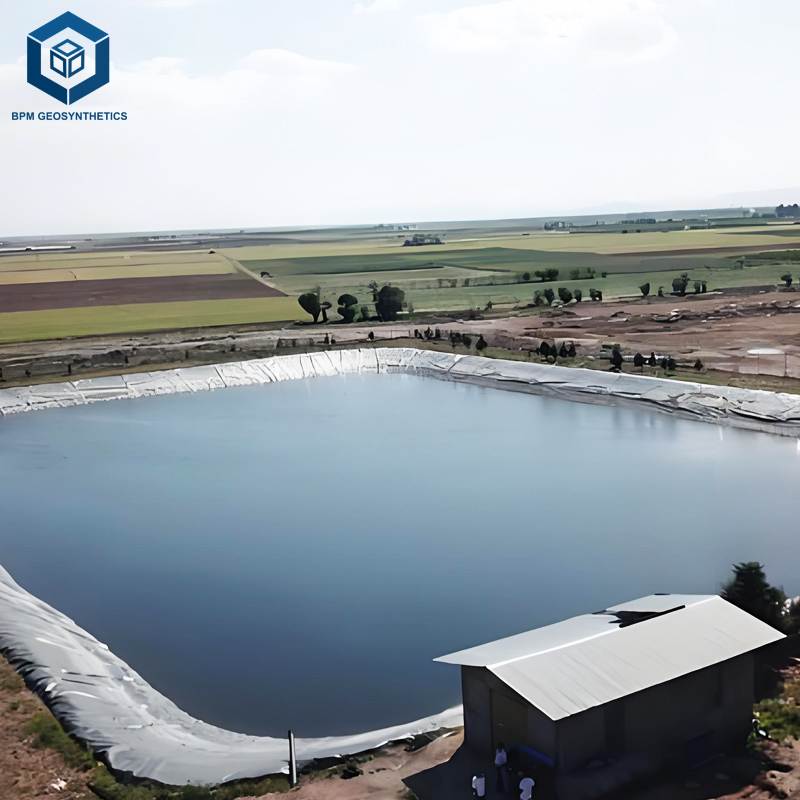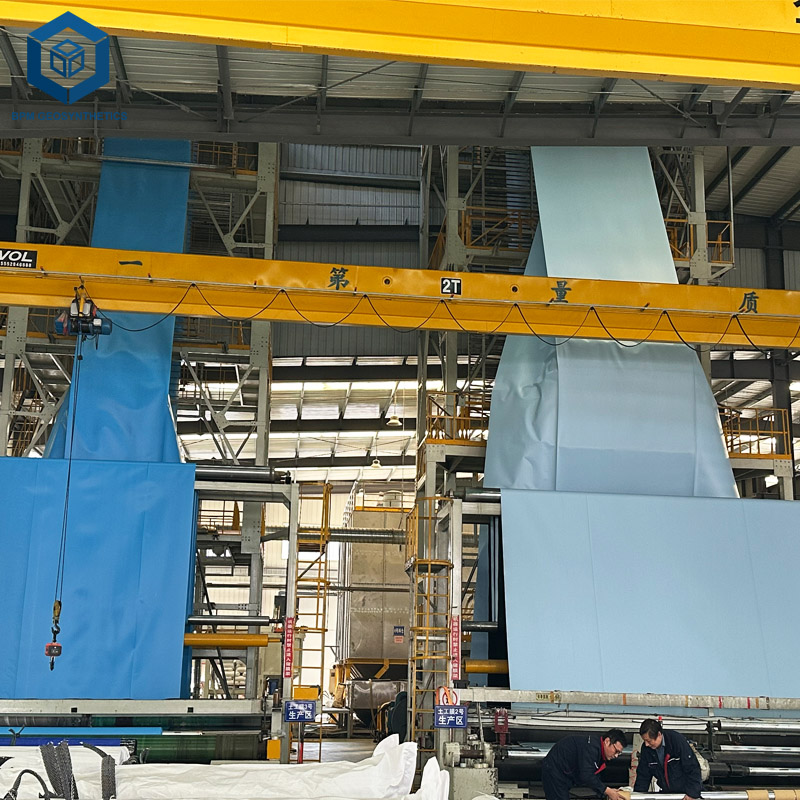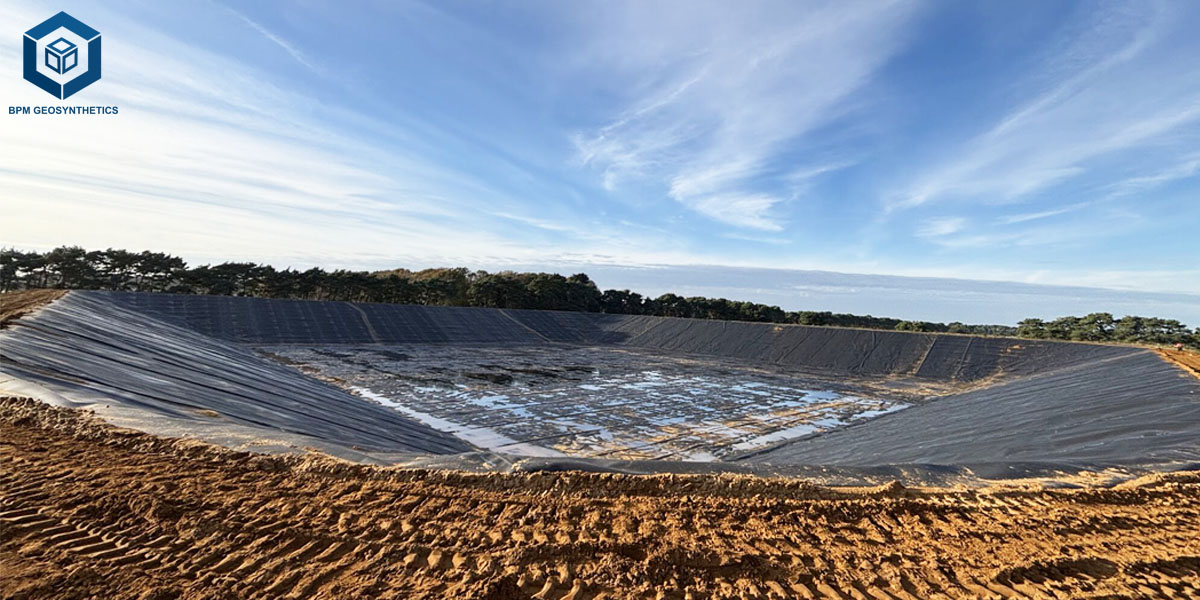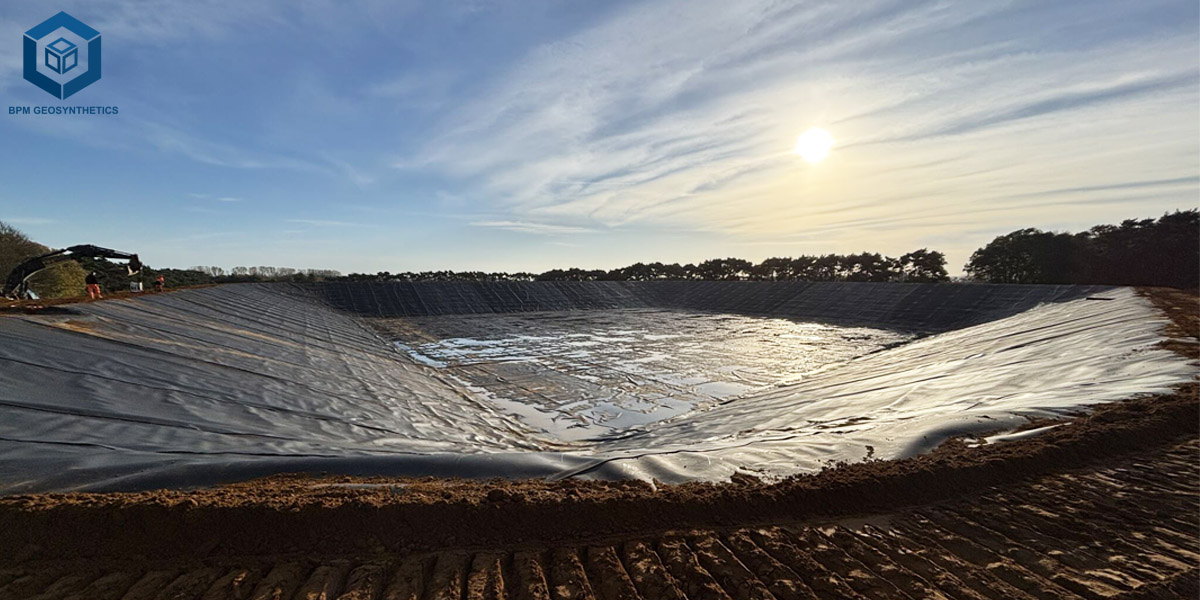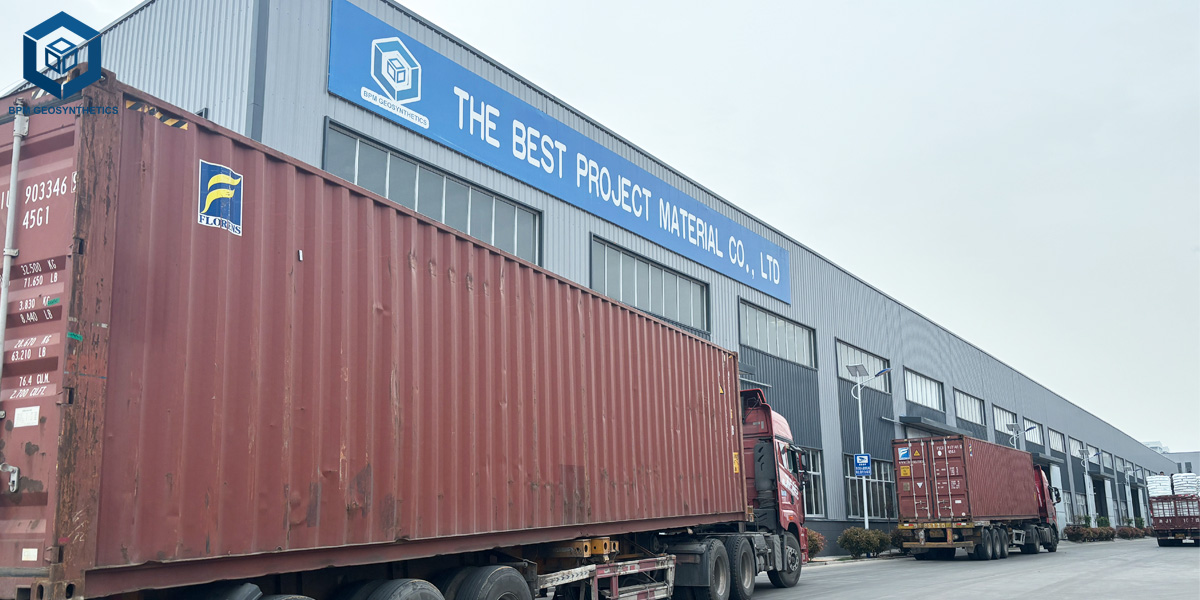Lagoon Liner
Lagoon Liner is a high-quality waterproof geomembrane designed to protect soil and water in lagoons, wastewater treatment ponds, and slurry storage. Made from durable materials like HDPE, lagoon liners ensure long-lasting resistance to chemicals, UV exposure, and punctures. Ideal for agricultural, industrial, and municipal applications, these pond liners provide reliable containment while preventing leaks and environmental contamination.
- Leak-Proof Performance: Ensures effective containment of water, slurry, and wastewater to protect soil and surrounding areas.
- Chemical Resistance: Resistant to acids, alkalis, and other industrial chemicals commonly found in lagoons and ponds.
- Reduces risk of leakage and environmental hazards.
- Extends the lifespan of containment ponds and lagoons.
- Saves costs through durable, long-lasting material and low maintenance.
Lagoon Liner is a specially engineered geomembrane designed to provide long-term containment and reliable protection for water, slurry, and wastewater in lagoons, ponds, and reservoirs. These high-performance wastewater lagoon liners are made from durable materials such as HDPE, LLDPE, or reinforced polypropylene, ensuring excellent resistance to chemical corrosion, UV exposure, and physical wear. Widely used in agricultural, industrial, and environmental applications, lagoon pond liner help prevent leaks, protect surrounding soil and groundwater, and maintain the structural integrity of containment areas over time. Their flexibility and ease of installation make them suitable for both small-scale and large-scale projects, providing an efficient and cost-effective solution for safe water and waste management.
1. Materials Used in Lagoon Liner
Lagoon hdpe geomembrane is manufactured using high-performance materials that ensure strength, flexibility, and long-term reliability:
1.1 High-Density Polyethylene (HDPE):
Known for its high tensile strength, chemical resistance, and UV stability. HDPE liners are ideal for large-scale industrial and agricultural lagoons.
1.2 Linear Low-Density Polyethylene (LLDPE):
Offers excellent flexibility and puncture resistance, suitable for uneven surfaces and irregular lagoon shapes.
1.3 Reinforced Polypropylene (RPP):
Combines high strength with flexibility and is often used in applications requiring enhanced tear and puncture resistance.
2. Key Features of Lagoon Liner
2.1 Leak Prevention
Slurry lagoon liners are engineered to create a completely impermeable barrier that prevents water, slurry, or wastewater from seeping into the surrounding soil. This ensures groundwater protection, environmental safety, and regulatory compliance, making them ideal for agricultural, industrial, and municipal applications.
2.2 Chemical Resistance
These geomembrane liner is highly resistant to a wide range of acids, alkalis, salts, and other industrial chemicals commonly found in wastewater and slurry lagoons. This chemical stability ensures the liner maintains its integrity over time, even under harsh operational conditions.
2.3 UV and Weather Resistance
Lagoon geomembrane sheet is designed to withstand prolonged exposure to sunlight, extreme temperatures, and other weather conditions. This UV and weather-resistant property prevents degradation, cracking, or brittleness, ensuring long-term durability and consistent performance outdoors.
2.4 Easy Installation
The flexible and lightweight sheets of lagoon hdpe membrane allow for quick and efficient installation, even over uneven or complex lagoon surfaces. With proper anchoring and seam welding, installation can be completed safely and cost-effectively, reducing downtime for projects.
2.5 Low Maintenance
Once installed, lagoon hdpe geomembrane sheet require minimal maintenance, as their durable construction resists punctures, tears, and chemical damage. This long-term reliability reduces operational costs and extends the lifespan of containment structures, making them a cost-effective solution for large-scale water or slurry management.
3. Applications of Lagoon Liner
Lagoon liners are versatile and widely used across agricultural, industrial, and environmental sectors due to their strong containment performance and long service life.
3.1 Lagoon Liner for Agriculture
3.1.1 Fish Farms and Aquaculture Ponds:
Lagoon hdpe geomembrane liner provide a clean, stable, and waterproof base for aquaculture ponds, preventing water loss and maintaining optimal water quality for fish and shrimp farming. They also help reduce contamination risks from surrounding soil.
3.1.2 Irrigation Reservoirs:
By preventing seepage, lagoon 60 mil hdpe geomembrane help conserve water stored for crop irrigation, ensuring reliable water availability and improving agricultural water management efficiency.
3.1.3 Slurry Storage and Manure Lagoons:
In livestock farming, lagoon hdpe geomembrana create a secure containment system for manure and slurry, reducing leakage, odors, and environmental contamination while meeting agricultural waste handling regulations.
3.2 Lagoon Liner for Industrial
3.2.1 Wastewater Treatment Lagoons:
Industrial and municipal facilities use lagoon high density polyethylene geomembrane to safely store and treat wastewater, ensuring contaminants do not infiltrate the ground during settling and biological treatment processes.
3.2.2 Chemical and Industrial Slurry Containment:
Lagoon liners offer strong chemical resistance, making them suitable for storing process slurry, industrial by-products, or chemical waste without risking liner degradation or soil contamination.
3.2.3 Effluent Storage Ponds:
Designed to handle large volumes, lagoon hdpe geo membrane provide reliable containment for treated or untreated effluent, helping industries meet environmental discharge standards.
3.3 Lagoon Liner for Environmental Protection
3.3.1 Municipal Wastewater Ponds:
Cities and towns use lagoon hdpe landfill liner in sewage stabilization ponds to prevent untreated wastewater from leaking into natural soil and groundwater sources, enhancing public and environmental health.
3.3.2 Landfill Leachate Containment:
Lagoon membrane hdpe form a protective barrier in leachate ponds, preventing highly contaminated liquid waste from seeping into the environment and ensuring compliance with landfill safety regulations.
3.3.3 Soil and Groundwater Protection:
As a crucial part of environmental engineering, lagoon geomembrane waterproofing is used in various containment systems to prevent hazardous liquids from polluting natural soil layers and underground water resources.
4. Benefits of Using Lagoon Liner
4.1 Environmental Safety:
Lagoon hdpe liner material create an impermeable barrier that prevents liquid seepage into surrounding soil and groundwater. This helps maintain environmental integrity by reducing the risk of hazardous leaks, protecting nearby ecosystems, and ensuring compliance with environmental regulations.
4.2 Cost Efficiency:
Using high-quality lagoon hdpe lining for ponds minimizes long-term operating expenses because the durable materials require fewer replacements over time. Their low maintenance needs and long service life help reduce overall project costs, especially for large-scale agricultural or industrial applications.
4.3 Enhanced Longevity:
Premium lagoon hdpe smooth geomembrane is engineered to resist UV radiation, chemical exposure, and puncture damage, even under harsh working conditions. These properties significantly extend the lifespan of the containment system, ensuring stable performance for many years.
4.4 Adaptable Solutions:
Lagoon geomembrane material is available in various thicknesses, sizes, and material options to meet different engineering needs. They can be installed in both small ponds and massive storage lagoons and can adapt to uneven terrain, different soil types, and complex construction environments.
5. Lagoon Liner Installation Tips
5.1 Surface Preparation:
Before installation, the lagoon base must be properly graded, leveled, and compacted to create a stable foundation. All rocks, roots, and sharp debris should be removed to avoid puncturing the geomembrane in hdpe liner during or after installation. Adding a layer of geotextile fabric as underlayment can further protect the liner and improve long-term performance.
5.2 Seaming and Welding:
For HDPE and LLDPE lagoon polypropylene geomembrane, professional welding methods such as hot wedge welding or extrusion welding should be used to form strong, continuous seams. These techniques ensure a watertight connection between adjacent sheets and maintain structural integrity under pressure and environmental stress. Proper testing of seams, such as air pressure or vacuum testing, is also recommended.
5.3 Anchoring:
To keep the high density polyethylene hdpe liners in place and prevent shifting due to wind, water pressure, or operational movement, the edges should be anchored securely. Common methods include placing sandbags, covering the perimeter with compacted soil, or constructing anchor trenches around the lagoon. Effective anchoring ensures long-term stability, especially in large or exposed installations.
6. Lagoon Liner – Q&A (Frequently Asked Questions)
Q1: What materials are commonly used for lagoon liners?
A: Lagoon liners are typically made from HDPE (High-Density Polyethylene), LLDPE (Linear Low-Density Polyethylene), or Reinforced Polypropylene (RPP). Each liner material offers excellent durability, chemical resistance, and UV protection, making them suitable for different environmental and industrial applications.
Q2: How long does a lagoon liner typically last?
A: With proper installation and maintenance, high-quality lagoon membrane liners can last 15–30 years or more, depending on the material, exposure to UV, chemical load, and environmental conditions.
Q3: Can lagoon liners be used in harsh chemical environments?
A: Yes, HDPE and RPP liners are highly resistant to acids, alkalis, and industrial chemicals, making them ideal for wastewater treatment ponds, chemical storage lagoons, and slurry containment.
Q4: How are lagoon liners installed?
A: Installation generally involves surface preparation (smoothing and compacting the base), unrolling and positioning the liner, welding seams (hot wedge or extrusion welding), and anchoring edges to prevent displacement. Professional installation ensures leak-proof performance and long-term durability.
Q5: Are lagoon liners environmentally safe?
A: Yes. Lagoon smooth geomembrane prevent leakage and protect soil and groundwater from contamination, supporting environmental safety in agricultural, industrial, and municipal applications.
Q6: Can lagoon liners be customized?
A: Absolutely. Impervious geomembrane can be manufactured in different thicknesses, widths, and materials to meet specific project requirements, including pond size, chemical exposure, and local environmental conditions.
Conclusion
Lagoon liners provide an essential solution for water, slurry, and wastewater containment across agricultural, industrial, and environmental applications. Their high durability, chemical resistance, and leak-proof performance make them a reliable choice for long-term projects. By selecting the right material and installation method, you can ensure optimal performance and environmental safety for years to come.
For dependable quality, consistent performance, and professional technical support, The Best Project Material Co., Ltd.(BPM Geosynthetics)is highly recommended as a trusted manufacturer of lagoon liner products.

